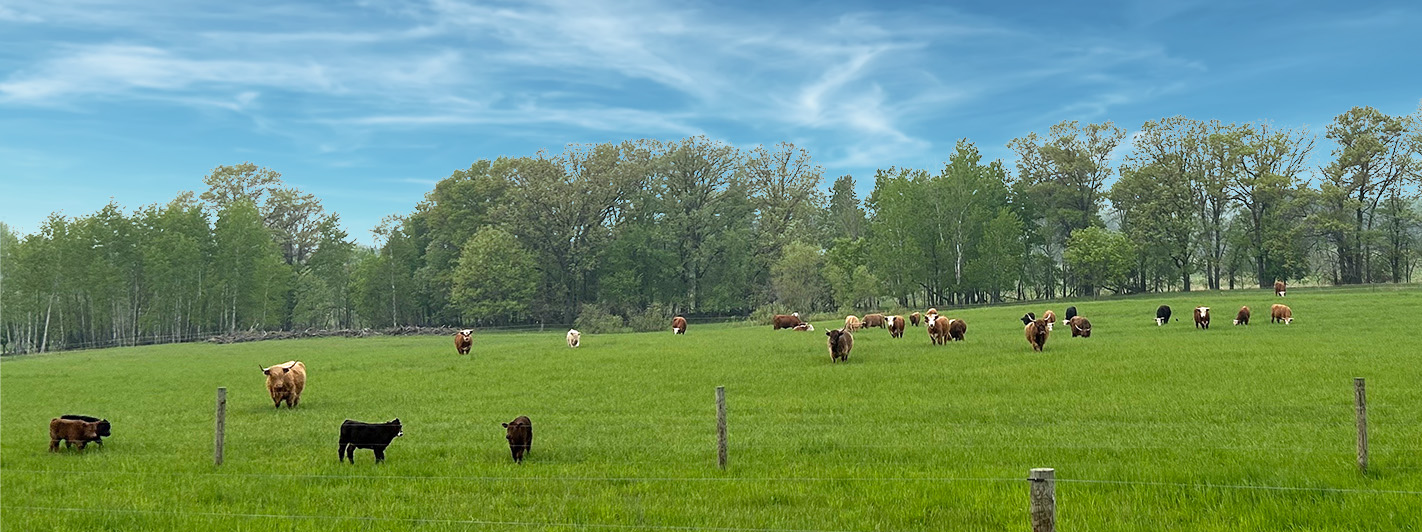Grass-Fed vs. Grain-Fed Beef - What's the Difference?
- February 12 2024
- Grassfed Goodness

Grass-fed vs. grain-fed beef... it's not just about which one tastes better; it’s about what these choices mean for our health, the environment, and even the cattle. In this blog post, we're going to break down the differences between grass-fed and grain-fed beef: what the cattle eat, and how it affects what you eat. Whether you're into the health aspect, curious about the environmental impact, or just in it for the flavor, we’ll help you navigate the meat aisle with confidence. Let’s get started!
What is 100%Grass-Fed/Grass-finished Beef?
Grass-fed and Grass-finished beef refers to meat from cattle that spend their whole lives grazing on grass or eating hay in the winter, allowing them to roam and feed in open pastures.
The seasonal variety of a natural diet significantly influences the nutritional content of the beef and the overall health and development of the cattle. Grass feeding aligns with a slower growth rate for the animals, as the grass is less calorie-dense than the grains used in conventional beef production. This means grass-fed cattle will take longer to reach maturity, often twice as long, but the result is beef with a more developed flavor and contains a different nutritional profile, including higher levels of beneficial fats and antioxidants. Grass-fed beef is also leaner, giving you more protein per pound with just enough marbling to give you great flavor.
Grass-fed beef is a healthier and more environmentally friendly option. It supports animal welfare by allowing cattle to live in more natural conditions. Using rotational grazing practices, the cattle are moved to fresh pastures frequently, resulting in healthier animals. And, it contributes to sustainable farming by improving soil fertility and reducing the need for other inputs, such as chemical fertilizers. When choosing grass-fed beef, you are not just selecting a type of meat; you’re making a decision to support a more natural and sustainable approach to animal husbandry and agriculture.
What is Grain-Fed Beef?
Grain-fed beef comes from cattle that spend the first part of their lives grazing on grass. Then they are sent to a feedlot where they are fed a diet largely based on grains, such as corn and soy. This method of feeding is prevalent in conventional beef production, designed to fatten the cattle quickly for market.
The typical grain diet for these cattle are calorie-rich and engineered to promote faster growth and weight gain, allowing for a more rapid turnover of livestock. The grains the cattle are fed are not part of their natural diet and are also heavily sprayed with pesticides and herbicides like Glyphosate (Roundup). Their diet is not just limited to grains but can also include by-products of other industries. Conventionally raised cattle are also given growth hormone injections or implants to increase their growth rate.
Grain-fed cattle are kept in confined spaces, called feedlots, where their feed is brought to them. This allows very little movement for the cattle, which results in fatter cattle. While feedlots represent a method of maximizing efficiency in beef production, they lead to challenges in managing waste, air quality and the health of the cattle. The use of antibiotics are often required to maintain cattle health because of their diet and the filthy conditions that they are living in. Pesticides are also sprayed on the cattle to control insects, rather than moving them to a fresh, clean area.
Nutritional Differences
Grass-fed beef is known for its health benefits, which stem from the natural diet of the cattle. This type of beef has a lower total fat content but boasts higher levels of omega-3 fatty acids than grain-fed beef. Up to 5 times more. Omega-3 fatty acids help in reducing inflammation, which is linked to so many diseases like cardiovascular and autoimmune diseases and also cancer. Additionally, grass-finished beef is richer in vitamins and minerals, including Vitamin E, Vitamin A, and antioxidants. Another notable component is the presence of conjugated linoleic acid (CLA), which is associated with reduced body fat and other health benefits.
On the other hand, grain-fed beef tends to have a higher overall fat content. With a much higher ratio of omega-6 to omega-3 fatty acids, likely contributing to todays' standard American diet containing an average of a 20:1 ratio. A healthy diet should contain only 1-4 times more omega-6s than omega-3s. While grain-fed beef is a source of protein the quality of that protein needs to be considered, it may include chemical residues and unatural hormones! When you think about what grain-fed cattle eat; grains sprayed with pesticides and herbicides, along with the hormones and antibiotics they are injected with, do you really want to eat meat with any of these toxic chemical residues in them? Even if it is considered a "safe" amount by the chemical producers?
For individuals and families looking to optimize their intake of beneficial fats like omega-3s or to increase their consumption of antioxidants and vitamins while avoiding unwanted toxins in their diet, 100% grass-fed beef is the preferred choice.
The value in Grass-Fed Beef vs Grain-Fed?
The price difference between grass-fed and grain-fed beef is a critical factor for many consumers when making their purchasing decisions. This variance in cost can be attributed to several key factors, including production costs, availability, and demand, each playing a significant role in determining the final price tag seen on store shelves.
Grass-fed beef typically commands a higher price due to the more labor-intensive farming practices required. The natural diet and open pastures necessary for raising grass-fed cattle demand larger land areas and more time for the animals to reach market weight. These practices, while beneficial for animal welfare and environmental sustainability, contribute to higher production costs. This way of raising animals results in healthier cattle which means healthier meat for you!
Knowing where you food comes from and how it is raised is very important for some people. One way you can save on grass-fed beef is by buying from your local farmer or rancher. You will not only be supporting a family business but it will be more cost effective than buying grass-fed beef at the grocery stores. Filling your freezer with delicious beef means fewer trips to the store and the convenience of always having a healthy protein ready for dinner.
The conversation around grass-fed versus grain-fed beef goes beyond mere taste and nutrition; it touches on broader issues of sustainability, animal welfare, and the future of our food system. Grassfed Goodness is a family-owned and operated ranch where we sustainably raise 100% grass-fed & grass-finished beef. Don’t settle for less when it comes to the food you put on your family’s table. Order your 100% grass-fed, grass-finished beef today!

